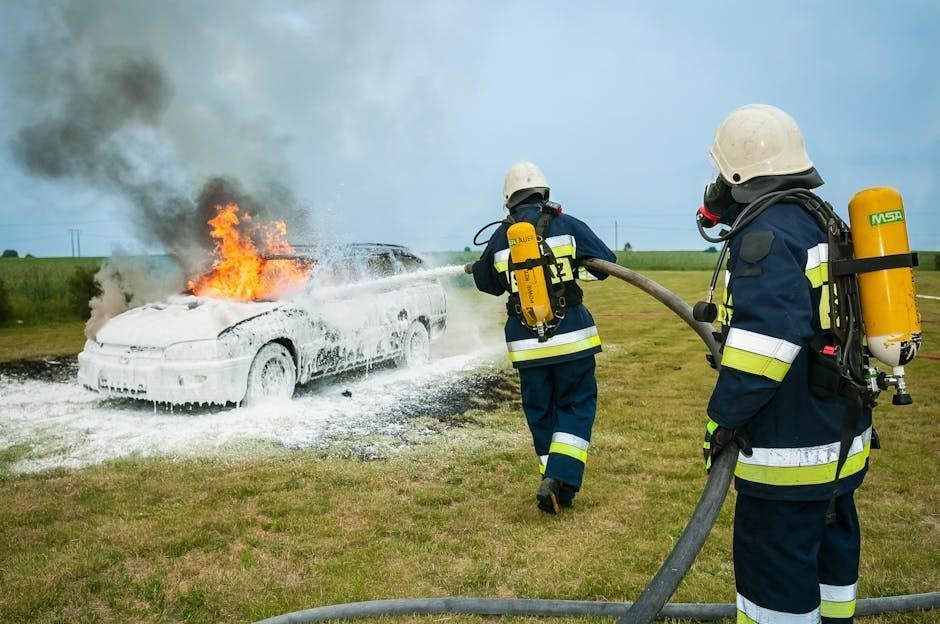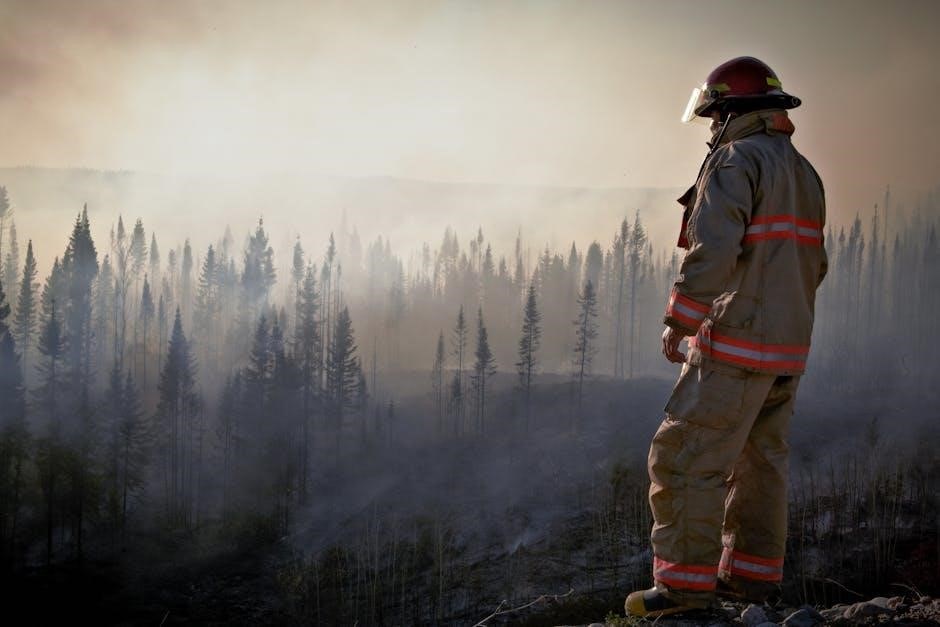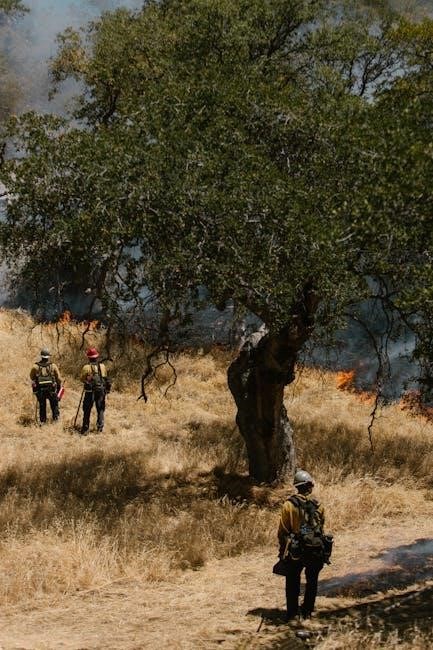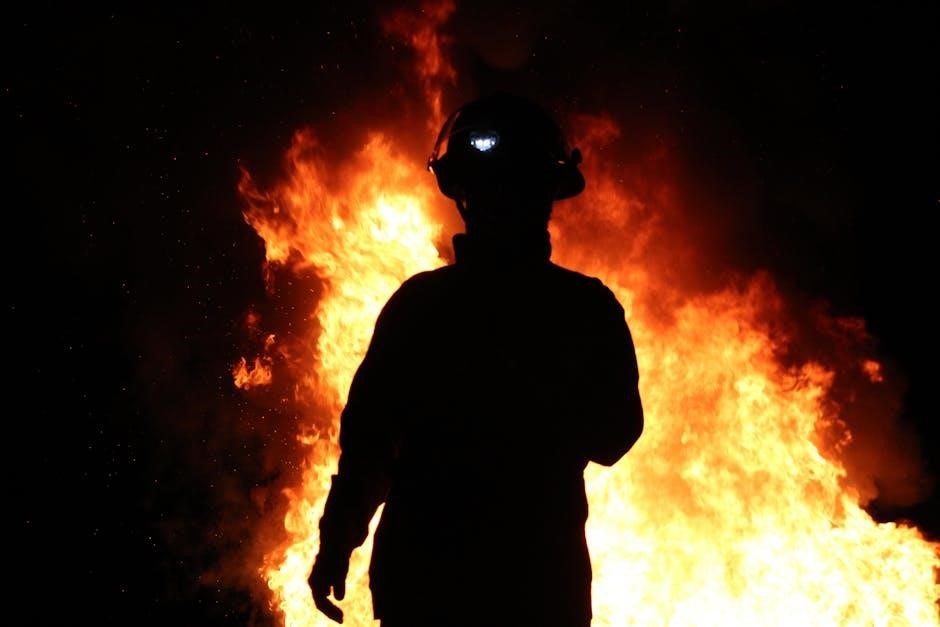The NFPA 10 standard, published by the National Fire Protection Association, provides essential guidelines for portable fire extinguishers. It covers selection, installation, inspection, and maintenance to ensure fire safety and effective emergency response. Widely adopted in the U.S. and globally, the standard is crucial for various industries. The NFPA 10 PDF is a key resource for understanding and implementing these critical fire protection measures.
1.1 Overview of the Standard
The NFPA 10 standard, developed by the National Fire Protection Association, outlines the minimum requirements for portable fire extinguishers to ensure their effectiveness in combating fires. It provides comprehensive guidelines for the selection, installation, inspection, maintenance, and use of fire extinguishers. The standard is widely recognized and adopted across various industries to enhance fire safety and protect lives and property.
Key aspects of the standard include fire classification, types of extinguishing agents, and the proper placement of extinguishers based on specific hazards. It also addresses the training needed for individuals to operate extinguishers safely and effectively. The NFPA 10 PDF document is a critical resource, offering detailed tables, diagrams, and annex sections that clarify complex requirements. By adhering to this standard, organizations can ensure compliance with federal and local fire safety regulations, reducing the risk of fire-related incidents.
The standard is regularly updated to reflect advancements in technology and fire safety practices, ensuring it remains a reliable and authoritative guide. Accessing the NFPA 10 PDF provides users with a complete understanding of how to implement its provisions effectively, making it an essential tool for fire safety professionals and organizations worldwide.
1.2 Purpose and Scope
The primary purpose of NFPA 10 is to establish minimum requirements for the selection, installation, inspection, and maintenance of portable fire extinguishers. Its scope ensures these devices are reliable and effective in combating fires, serving as a first line of defense against small, contained fires. The standard applies to all types of portable extinguishers, including water, foam, dry chemical, and carbon dioxide, among others.
By adhering to NFPA 10, organizations can ensure compliance with federal and local fire safety regulations. The standard is particularly relevant for facility managers, safety professionals, and building owners responsible for maintaining fire-safe environments. It also serves as a reference for fire marshals and inspectors enforcing fire codes. The scope of NFPA 10 is comprehensive, addressing both the technical aspects of extinguisher performance and the practical considerations for their use in various settings.
Ultimately, the standard aims to protect people, property, and the environment by ensuring portable fire extinguishers are always ready for emergency use. Its guidelines are integral to fire safety programs worldwide, making it a cornerstone of fire protection practices.

Development and Updates of NFPA 10
The NFPA 10 standard is regularly updated to reflect advancements in fire safety and technology. Recent editions include provisions for electronic monitoring and clarify requirements for obsolete extinguishers, ensuring the standard remains relevant and effective in modern fire protection scenarios.
2.1 History and Evolution
The NFPA 10 standard has a long history of development, dating back to its initial creation to address the growing need for standardized fire safety practices. First introduced, it focused on basic guidelines for portable fire extinguishers, aiming to ensure reliability and effectiveness in emergency situations. Over the years, the standard has undergone significant revisions to keep pace with technological advancements and evolving fire hazards. For instance, the 2013 edition introduced updated classifications for fire types and expanded requirements for extinguisher maintenance. The 2018 edition further refined these guidelines, incorporating new provisions for electronic monitoring systems and addressing obsolete equipment. These updates reflect the NFPA’s commitment to adapting to modern fire safety challenges. Today, NFPA 10 is a cornerstone of fire protection, widely adopted across industries and jurisdictions. Its evolution demonstrates a continuous effort to enhance safety and reduce fire-related risks through evidence-based practices and stakeholder collaboration.
2.2 Recent Edition Updates
Recent editions of NFPA 10 reflect advancements in fire safety technology and practices. The 2013 to 2018 updates introduced significant changes, such as enhanced requirements for electronic monitoring systems, which improve tracking of extinguisher readiness. Additionally, the standard now addresses obsolete extinguishers, ensuring they are phased out and replaced with safer, more reliable options. Fire classification markings were also updated to align with modern hazard identification, making it easier to select the right extinguisher for specific fire types. Maintenance procedures for hose stations were expanded, emphasizing thorough inspection and testing to prevent equipment failure during emergencies.

The 2022 edition further refined these updates, incorporating feedback from stakeholders and incorporating new technologies. It also clarified guidelines for inspecting and maintaining extinguishers in challenging environments, such as outdoor or high-hazard locations. These updates ensure NFPA 10 remains a comprehensive and adaptable standard for fire safety. The NFPA 10 PDF provides detailed insights into these changes, offering a valuable resource for compliance and implementation.

Core Requirements of NFPA 10

The standard outlines essential criteria for portable fire extinguishers, including selection based on fire type and size, proper installation, and regular inspection and maintenance. It ensures extinguishers are reliable and effective in emergency situations, aligning with fire safety best practices.
3.1 Selection of Portable Fire Extinguishers
The selection of portable fire extinguishers is a critical component of fire safety, as outlined in NFPA 10. The standard emphasizes that extinguishers must be chosen based on the specific hazards present in a facility. Factors such as the type and size of potential fires, the class of fire (A, B, C, D, or K), and the presence of electrical or flammable liquids are key considerations. For example, water-based extinguishers are effective for Class A fires involving ordinary combustibles, while CO2 or dry chemical extinguishers are better suited for Class B fires involving flammable liquids. Additionally, the standard requires that extinguishers be appropriately rated for the maximum anticipated fire size. NFPA 10 also stresses the importance of accessibility, ensuring that extinguishers are located within a reasonable distance from potential fire hazards. Proper selection ensures that extinguishers are both effective and safe to use in emergency situations, aligning with the overall goal of fire prevention and control.
3.2 Installation Requirements
The installation of portable fire extinguishers is governed by specific requirements in NFPA 10 to ensure they are readily accessible and functional in emergency situations. The standard mandates that extinguishers be installed in locations that are easily visible and reachable, with a maximum height of 5 feet from the floor to the top of the extinguisher. This ensures that individuals, including those with physical limitations, can access them without difficulty. Additionally, extinguishers must be placed along escape routes and in areas where fires are most likely to occur, such as near exits, in corridors, and in rooms with hazardous materials.
Installation also involves securing extinguishers to prevent movement or tampering. For example, extinguishers in high-traffic areas or vehicles must be firmly mounted to avoid displacement; The standard further specifies that certain types of extinguishers, such as those rated for cooking fires (K-class), must be installed in specific locations like commercial kitchens. Proper installation is critical to ensure compliance with safety regulations and to maximize the effectiveness of extinguishers in fire emergencies.
Failure to adhere to these requirements can result in fines, legal liabilities, and increased fire risks. Therefore, businesses and facilities must carefully follow NFPA 10 guidelines to ensure extinguishers are installed correctly and maintained regularly. The NFPA 10 PDF provides detailed diagrams and charts to guide proper installation practices.

3.3 Inspection and Maintenance
Regular inspection and maintenance of portable fire extinguishers are critical to ensuring their reliability in emergency situations; NFPA 10 outlines detailed procedures for both monthly and annual inspections to verify that extinguishers are fully functional and compliant with safety standards. Monthly inspections involve checking the extinguisher’s visibility, accessibility, and physical condition, including the pressure gauge, nozzle, and tamper seal. Any damage, leakage, or obstruction must be documented and addressed promptly.
Annual maintenance requires a more thorough examination, typically performed by a certified technician. This includes internal inspections, hydrostatic testing of cylinders, and recharging or replacing extinguishing agents as needed. The standard also mandates that extinguishers be serviced in accordance with the manufacturer’s instructions and that records of all inspections and maintenance activities be kept for compliance audits. Non-compliance with these requirements can lead to fines, legal liabilities, and increased fire risks.
The NFPA 10 PDF provides comprehensive guidelines and checklists to facilitate these processes, ensuring that fire safety professionals can maintain extinguishers effectively. Proper inspection and maintenance are essential to safeguarding lives and property by guaranteeing that extinguishers are ready to perform when needed.
Training and Education
Proper training and education are essential for the safe and effective use of portable fire extinguishers. NFPA 10 emphasizes the importance of training programs to ensure individuals understand fire classification, extinguisher types, and operational procedures. Regular updates and hands-on practice are recommended to maintain proficiency and compliance with fire safety standards. The NFPA 10 PDF provides detailed guidelines and resources to support comprehensive training initiatives, ensuring that personnel are well-prepared to respond to fire emergencies effectively.
4.1 Training Requirements
Training is a critical component of NFPA 10, ensuring individuals can safely and effectively use portable fire extinguishers. The standard mandates that all personnel who may operate extinguishers must receive proper training. This includes understanding fire classification, selecting the appropriate extinguisher type, and mastering operational procedures. Initial training should cover hands-on practice, while refresher courses are required at least annually to maintain proficiency. Employers are responsible for ensuring that employees are trained according to the standard’s guidelines. The NFPA 10 PDF provides detailed instructions for developing and implementing training programs, emphasizing the importance of both theoretical knowledge and practical skills. Training must also address specific workplace hazards and the proper use of extinguishers in various scenarios. By adhering to these requirements, organizations can ensure a safer environment and effective emergency response. Regular updates to the standard highlight the need for ongoing education to stay compliant and prepared.
4.2 Best Practices for Training Programs

Effective training programs for portable fire extinguisher use, as outlined in the NFPA 10 PDF, should incorporate best practices to ensure comprehensive understanding and practical proficiency. Hands-on training is essential, allowing participants to practice extinguisher operation in a controlled environment. Programs should also include regular updates to reflect changes in the standard or new equipment. Interactive elements, such as simulations and case studies, can enhance engagement and retention. Trainers should emphasize the importance of fire classification, proper extinguisher selection, and safe operating techniques. Additionally, programs should address common mistakes and stress the critical role of maintenance and inspection. Visual aids, such as diagrams and videos, can supplement instruction and clarify complex concepts. Employers should tailor training to specific workplace hazards, ensuring relevance and applicability. Finally, training should be documented, with records maintained to verify compliance. By following these best practices, organizations can create a well-prepared workforce capable of responding effectively in fire emergencies.

Compliance and Enforcement
Compliance with NFPA 10 is enforced through federal regulations like 46 CFR 25.01-3 and local adaptations. Authorities conduct inspections to ensure adherence, with penalties for non-compliance. Proper documentation and training are critical for meeting these fire safety standards effectively.

5.1 Federal Regulations and Standards
Federal regulations play a crucial role in enforcing compliance with NFPA 10. The standard is incorporated into U.S. law through the Code of Federal Regulations (CFR), specifically under 46 CFR 25.01-3, which mandates its adoption for maritime applications. This ensures that portable fire extinguishers meet rigorous safety standards across industries. Federal agencies, such as OSHA and the U.S. Coast Guard, enforce these regulations, requiring employers and vessel operators to adhere to NFPA 10 guidelines. Non-compliance can result in penalties, fines, and legal action. The integration of NFPA 10 into federal law underscores its importance as a national benchmark for fire safety. By aligning with these regulations, organizations ensure a safer environment and reduce fire-related risks. Regular updates to the standard are reflected in federal codes, making it essential for stakeholders to stay informed about the latest editions and amendments.
5.2 Local and State Adaptations
While NFPA 10 provides a national framework, local and state authorities often adapt the standard to address specific regional needs. These adaptations may include additional requirements for fire extinguisher placement, types, or maintenance frequencies based on local fire hazards, climate, or infrastructure. For example, coastal regions might emphasize corrosion-resistant extinguishers, while industrial areas could require specialized agents for chemical fires. States and municipalities may also establish stricter enforcement protocols or supplementary training requirements for personnel. Local fire departments typically oversee compliance, conducting inspections and certifying that systems meet both NFPA 10 and local codes. These adaptations ensure that fire safety practices are tailored to unique community risks while maintaining the core principles of the standard. It is essential for organizations to consult both the NFPA 10 PDF and local regulations to ensure full compliance. This dual approach balances national consistency with regional flexibility, enhancing overall fire safety effectiveness.

Accessing the NFPA 10 PDF
The NFPA 10 PDF is available for download from the National Fire Protection Association website and trusted sources like Public.Resource.Org. It includes guidelines for portable fire extinguishers, updates, and essential notices for users. Ensure you access it from official sources for authenticity and compliance.
6.1 Features of the PDF Document
The NFPA 10 PDF document is a comprehensive resource that provides detailed guidelines for portable fire extinguishers. It includes sections on selection, installation, inspection, and maintenance, ensuring compliance with fire safety standards. The document features tables such as Table 10.A, 10.B, and 10.C, which outline classifications of fire hazards and extinguisher requirements. It also covers updates like electronic monitoring of extinguishers and the phase-out of obsolete models. The PDF includes important notices and disclaimers regarding patents, laws, and regulations. Additionally, it offers references to other NFPA standards, such as NFPA 70E and NFPA 37, for broader fire safety context. The document is designed for easy navigation, with clear headings and sections for quick access to specific information. It serves as a vital tool for fire safety professionals, building owners, and anyone responsible for fire protection systems. By downloading the NFPA 10 PDF, users gain access to a standardized framework for ensuring fire readiness and compliance with federal and local regulations.
6.2 Additional Resources and References
Beyond the NFPA 10 PDF, several additional resources are available to support fire safety professionals and individuals seeking in-depth knowledge. The National Fire Protection Association (NFPA) offers complementary standards such as NFPA 70 (National Electrical Code) and NFPA 37 (Standard for the Installation and Use of Stationary Combustion Engines and Gas Turbines). These documents provide a broader context for fire safety and protection systems. Additionally, the NFPA 10 PDF references tables like Table 10.A, 10.B, and 10.C, which classify fire hazards and outline extinguisher requirements. For historical context, previous editions of the standard, such as the 2013 and 2018 versions, are available for comparison. Online platforms like NFPA LiNK offer digital access to codes, expert commentary, and training materials. Furthermore, organizations like Public.Resource.Org and Archive.org provide free access to NFPA documents, including the NFPA 10 PDF, to enhance public safety and awareness. These resources ensure that users can stay informed and compliant with the latest fire protection guidelines.
The NFPA 10 standard serves as a cornerstone for fire safety, providing critical guidelines for the selection, installation, and maintenance of portable fire extinguishers. By adhering to its requirements, individuals and organizations can ensure effective fire protection, safeguarding lives and property. The standard’s emphasis on regular inspections and training underscores its commitment to preparedness and safety.
Access to the NFPA 10 PDF and related resources, such as historical editions and complementary standards like NFPA 70 and NFPA 37, offers a comprehensive approach to fire safety. These materials are essential for staying informed about updates and best practices, ensuring compliance with the latest industry standards.